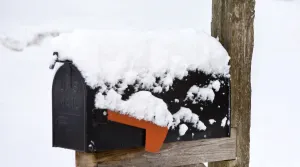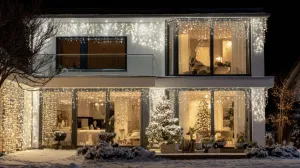Light problems from neighbors can be fixed by taking clear steps to track, talk, and solve the issue. First, owners should check and write down how bright the light is using light meters. Then, they should talk openly with neighbors about how the light affects them. Quick fixes like putting up curtains, shades, or plants can help block unwanted light. Better long-term answers include using lights that turn on with movement, adding shields to keep light from spreading, or changing where lights point. Working with local rules and getting the community involved can help make lasting changes.
Key Takeaways
- Start friendly conversations with neighbors about their lighting’s impact and suggest collaborative solutions like adjusting fixture angles or using motion sensors.
- Document light pollution issues with photos, measurements, and records of communication attempts for potential legal or HOA intervention.
- Install physical barriers like tall evergreens, window films, or blackout curtains to block unwanted light from neighboring properties.
- Research local lighting ordinances and file formal complaints with municipal authorities if neighborly discussions prove unsuccessful.
- Join or create community initiatives to raise awareness about light pollution and advocate for better lighting standards in your neighborhood.
Understanding Different Types of Light Pollution
Light pollution comes in four main types: skyglow, glare, light trespass, and clutter.
Cities create a bright dome of light in the sky that blocks out the stars and affects animals that are active at night.
Light trespass happens when unwanted light shines into nearby homes or spaces, making it hard for people to sleep and causing stress.
Too much bright light creates glare, which is bad for both people’s health and nature.
Light clutter shows up as too many bright lights in outdoor areas, making spaces look messy and hard to see clearly.
When we know about these different types of light pollution, neighbors can work together to fix each problem in the right way.
Documenting the Light Pollution Impact
Documentation of light pollution impacts requires systematic measurement of illumination levels using lux meters or sky quality meters at consistent times throughout a 24-hour period.
Property assessors and real estate specialists can quantify the economic effects by analyzing home values and rental rates in areas with varying degrees of light pollution.
These data points enable communities to establish baselines, track changes over time, and calculate both the environmental and financial costs of excessive artificial lighting.
Tracking Light Levels Daily
Measuring light levels each day helps us understand and fix unwanted lighting in any area. Taking daily readings lets us know what’s normal and spot when light becomes a problem.
You can use simple light meters or phone apps to gather this information easily, both for right now and over time.
- Take readings at set times during the night
- Write down weather that might affect the readings
- Show how light strength changes in different spots
- Keep track of how lighting shifts with the seasons
- Watch how light levels link to nearby events and tasks
By checking light levels this way, you build up solid facts that help solve lighting problems.
This information makes it easier to talk with neighbors, city officials, and groups that want to cut down on light pollution.
Recording Property Value Effects
Light pollution can hurt how much homes are worth, so keeping good records is important. Homeowners should get their property’s value checked by experts both before and after bright lights become a problem.
Real estate agents who know the area well can help track how home prices drop in neighborhoods affected by too much light at night.
Having clear records makes it easier to ask the city or town for help in fixing light problems. Important records should include pictures, nearby home sale prices, and statements from experts who can show how bright lights are lowering property values in specific areas.
Reviewing Local Light Ordinances and Regulations
Learning about local rules for outdoor lighting helps communities deal with light pollution. By knowing these rules, people can better understand how to follow them and make sure others do too.
- Look up city rules about light shining onto other properties
- Find out which types of lights are allowed and how to put them up
- Learn about different rules for business and home lighting
- Know when lights need to be turned off at night
- Find out how to report problems and how rules are enforced
Cities with good lighting rules usually keep their information at city planning offices. This makes it easy for people to find what they need to know about following the rules and getting help when there are problems.
Initiating a Friendly Dialogue With Neighbors
Talking to neighbors about bright lights needs to be friendly and helpful, not angry. You can start by sharing facts about how too much light at night can harm animals, make it hard to sleep, and waste money on power bills.
When you meet, you can work together to find ways that help everyone – like pointing lights downward or adding sensors that turn them on only when needed. Most people don’t know their lights might be a problem and are happy to learn about easy fixes.
It’s best to talk during the day when you can look at the lights together and figure out good solutions that work for both sides.
Practical Solutions for Light Blocking
You can block unwanted light from your home and sleep better with easy fixes that work well. These fixes help keep good ties with neighbors while making your home darker at night.
- Put up thick, dark curtains that also keep heat in.
- Add outdoor blinds you can move up and down.
- Grow tall trees or bushes that stay green all year.
- Put special film on windows to cut down bright light but let you see out during day.
- Use pretty screens or wood frames to block and move light away.
These steps help you control light while staying friendly with your neighbors.
Installing Proper Light Shields and Barriers
Light pollution mitigation requires carefully selected directional light fixtures that focus illumination downward onto specific target areas rather than allowing light to scatter upward or horizontally.
Installing full cutoff fixtures and adjustable shields helps prevent light trespass while maintaining necessary ground-level visibility for safety and functionality.
Strategic placement of trees and tall shrubs creates natural light barriers that can effectively block unwanted artificial light from entering sensitive areas or neighboring properties.
Choosing Directional Light Fixtures
Smart lighting choices can help reduce light pollution by using fixtures that point light where it’s needed. Today’s lights can save energy and shine light in specific spots, cutting down on scattered light while keeping areas bright enough to see.
- Lights that point straight down and block upward glare
- Lights that turn on only when they sense movement
- Short lights along paths that shine in a narrow beam
- Built-in lights with special shields inside
- LED lights you can aim and adjust for brightness
These targeted lighting options keep light from spilling onto nearby homes and yards while lighting up the right spots, making outdoor spaces better lit and more neighbor-friendly.
Strategic Tree Barrier Placement
Light safety is important, but well-placed trees and plants can help block unwanted light from spreading too far or shining too brightly.
When picking trees for this purpose, you need to think about how tall they’ll grow, how thick their leaves will grow, and how fast they’ll reach their full size. Trees that stay green all year work well as light blockers, while trees that lose their leaves give you different options across seasons.
To make this work best, put trees between the lights and the places you want to protect from light. Make sure to check if the spot gets enough sun, has good soil, and follows local rules.
Using different types of plants at different heights works better at blocking light and helps local wildlife and nature stay healthy.
Working With Property Management and HOAS
Property managers and homeowners’ groups (HOAs) set the rules for lighting in many neighborhoods. To fix light pollution, you need to work with these groups to make changes that help everyone.
Start by checking the current HOA rules about lighting. Then, suggest new ideas for lights that don’t cause glare or waste energy.
Go to HOA meetings to explain why better lighting matters. Share helpful information about how too much light affects people and nature. Get neighbors together to work on making lighting better.
When you work with property managers and follow HOA steps, you can make real changes that last. This careful way of doing things keeps everyone happy while making nighttime lighting cleaner and safer.
Technical Solutions and Light Measurements
To fix light pollution problems, we need good measurements and know-how. Light meters can track how bright lights are and show where light spills into unwanted areas. This helps us understand what needs to fix and prove there’s a problem.
Simple fixes include putting up motion-triggered lights, pointing lights in better directions, adding covers to block glare, and using smart controls that adjust lighting.
Legal Options and Formal Complaints
You can take legal action if bright lights from nearby properties are causing problems. Local rules about lighting, property use, and public disturbances protect residents from unwanted light.
- Report the problem to local officials who check building rules.
- Ask for help from community mediators to solve the dispute.
- Take pictures and notes about how the light affects you.
- Look up your town’s rules about outdoor lights.
- Tell your homeowners group or building manager about the problem.
Keep good records when you take action. Save proof of how you tried to work things out with your neighbor first.
Most towns want you to try solving the problem directly before they step in to help.
Community Awareness and Advocacy
Building community awareness around light pollution requires strategic grassroots initiatives through neighborhood meetings, environmental education programs, and collaborative networks.
Local groups can organize educational sessions focusing on responsible lighting practices, energy conservation, and protection of nocturnal ecosystems.
These community-level efforts create crucial support structures for implementing light pollution reduction measures and advocating for policy changes at the municipal level.
Organizing Neighborhood Light Meetings
Bringing neighbors together to talk about outdoor lighting helps make positive changes in the area. To run good meetings that get results, you need to plan carefully and make sure everyone can join in.
- Pick a meeting place that works for everyone
- Make a clear list of lighting problems to discuss
- Bring pictures and light readings to show examples
- Set basic rules for polite discussion
- Write down what needs to be done and who will do it
These meetings help neighbors work together to fix lighting problems. People can share ideas and tools, and agree on good lighting practices that help everyone while keeping the night sky dark and protecting nature.
Starting Environmental Education Programs
Learning about light pollution helps people understand why it matters and how to fix it.
Towns and cities can run simple workshops that show how too much artificial light at night affects wildlife, our health, and wastes energy. These workshops work best when people can try things themselves, like using tools to measure light or looking at the night sky.
To spread the word, groups can share easy-to-read materials at schools, libraries, and community buildings.
They should focus on showing people real ways to help, like picking the right outdoor lights and using timers.
It also helps to share stories about other places that have cut down on light pollution and seen good results.
Building Local Support Networks
Working together with neighbors is key to cutting down bright lights at night.
When people team up and learn from each other, they can better fix lighting problems in their area. Meeting as a group helps create good changes that last.
What you can do:
- Start neighborhood groups that care about dark skies
- Work with stargazers and nature groups nearby
- Set up meetings to teach good lighting habits
- Make online groups to share tips and wins
- Find helpers who know about fixing bright lights
When people work as a team, they can make bigger changes that help everyone.
Small efforts grow into big results when neighbors support each other in keeping the night sky dark.
Frequently Asked Questions
How Does Light Pollution Affect Nocturnal Wildlife in Residential Areas?
Too much artificial light at night causes big problems for animals that are active after dark. Night lights mess up when these animals eat, mate, and move around. The bright lights can force them to leave their homes and change how hunters catch their prey and how prey animals try to stay safe.
Can Light Pollution From Neighboring Properties Decrease My Home’s Resale Value?
Light coming from nearby properties can lower your home’s selling price. More and more home buyers want darker night skies and care about the environment when choosing where to live, making bright outdoor lights a drawback.
What Health Issues Are Linked to Prolonged Exposure to Light Pollution?
Too much artificial light at night messes up our body’s natural sleep-wake cycle, making it hard to get good sleep. This can make people feel worried, sad, and harm their mental well-being. Studies show that it might also hurt heart health and weaken the body’s ability to fight off illness.
Are There Tax Incentives for Installing Light Pollution Reduction Equipment?
Many places give tax breaks and money to help pay for lights that reduce nighttime glare, especially in areas that want to protect dark skies or have programs to help the environment.
How Do Seasonal Changes Impact the Severity of Light Pollution Problems?
Seasons affect how bad light pollution gets during different times of the year. When days grow shorter, people use more lights to see in the dark. Winter brings more light pollution because we need extra lighting. Weather plays a role too – clouds and storms can make artificial light look brighter or dimmer in the night sky.
Conclusion
Addressing light pollution requires both practical steps and legal guidance. Working with Ace California Law can help ensure your rights are protected while dealing with intrusive lighting from neighboring properties. Property owners can reduce light trespass through technical solutions like proper shielding, motion sensors, and adjusting lighting fixtures. By combining these measures with community outreach and knowledge of local regulations, you can create effective solutions that protect both your property rights and the natural environment. Working with neighbors and local authorities while supporting dark-sky initiatives helps build lasting improvements that benefit individual properties and the wider ecosystem.






